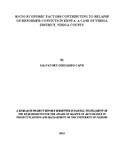| dc.description.abstract | Incidences of repeat offending have remained elusive amidst major efforts in
transforming the societies for betterment. Correctional institutions have tried all that could be
done to address notable negative behavioral characters but little remains to be observed.
According to the Kenya Prison Reform Centre (KPRC), nearly two thirds of prisoners in
Kenya re-offend within two years of release. However, factors that compel reformed convicts
to relapse even after leaving prisons are not well understood. This study therefore examined
the socio-economic factors that contribute to the relapse of reformed convicts in Kenya, with
a specific view of Vihiga district. The study examined the following specific objectives:
investigated how unemployment has contributed to the relapse of the reformed convicts
within Vihiga District, examined Education as a factor in the relapse of reformed offenders
within Vihiga District, analyzed the effects of drug abuse and how it has encouraged the
relapsing of the reformed convicts within Vihiga District and assessed the attitudes of the
community towards the reformed convicts and its effects in their relapse within Vihiga
District. The study was guided by labeling theory to help understand how labels shape human
behavior. The study area was Central Maragolli location of the Vihiga district. The total
population of reformed convicts in the location was unknown due to the sensitivity of the
attribute under study. The reformed convicts were therefore sampled through snowballing
until saturation levels were reached. Simple random sampling was also done on Central
Maragoli’s house hold population of 5310 and a sample of 372 drawn based on Glen Israel’s
formula of determining sample size. The 372 households were targeted for a community
survey. For the Ex-convicts, purposive sampling technique was utilized. 12 in-depth
interviews were carried out with ex-convicts. The data collected was analyzed both
quantitatively as well as qualitatively. The study findings pointed out that unemployment as a
component of socio-economic factor contributed greatly to the relapse of the reformed
convicts; with discrimination of the convicts leading the pack at 96.3%, suspicions rate at
83.9%, lack of locally viable skills at 83.9%, low educational levels and unmet ambitions at
64.9%. Educational level as a component of socio-economic factor contributed to the relapse
of the reformed convicts with over 90% of those who recidivate being at primary levels while
the number diminishes as one climbs higher levels in education. None was found to have
relapsed at the University level of education. Drug abuse and addiction among the reformed
convicts was also established to have contributed at 92.5% of the relapsed cases of the
reformed convicts. Low and negative community attitude with heightened suspicions among
the community members were among key factors that greatly contribute to the relapse of the
reformed convicts. They have destroyed societal fibers meant to keep communities knit
together. The study therefore concluded and recommended that; early identification and
nurturing of local talents and individual initiatives be enhanced to reduce the future life
explosion in the unemployment phenomenon. Programs that offer bursaries and other
educational support as well as prevailing upon local leadership to initiate institutions of
higher learning within the District to be enhanced in order to improve education standards.
There is an argent need to domesticate and effectively implement the existing policy on drug
use and abuse within the District. The already locally existing programs be effectively
involved in transforming the negative community attitude toward the reformed convicts
which increases their chances of relapsing after rehabilitation. Amongst others, the study
proposed further research on challenges facing the Rehabilitation Programs on Offenders
management within the community. | en |

